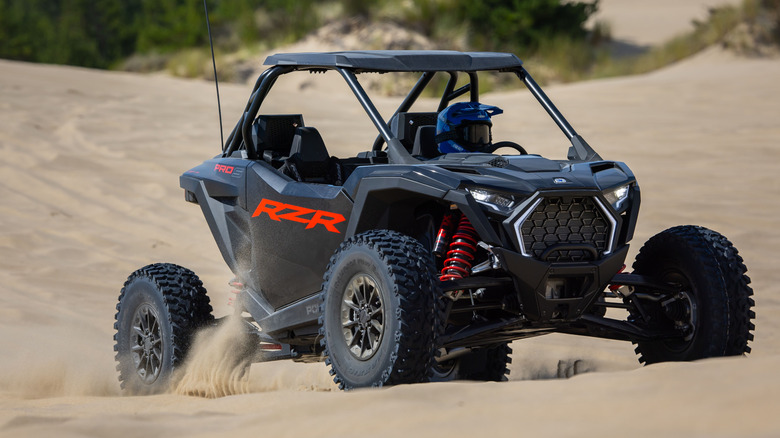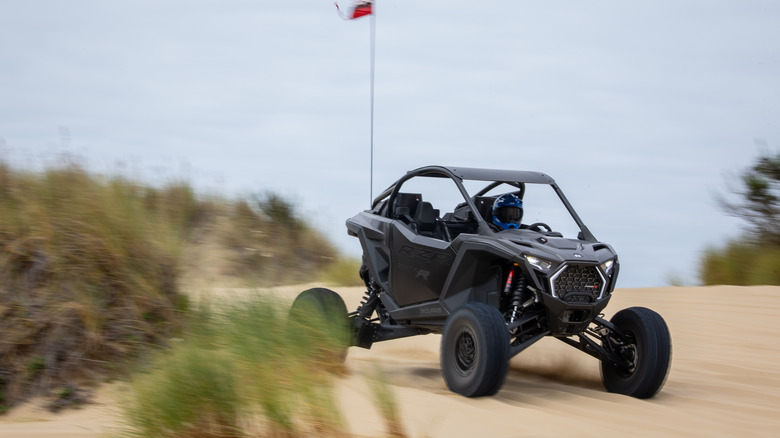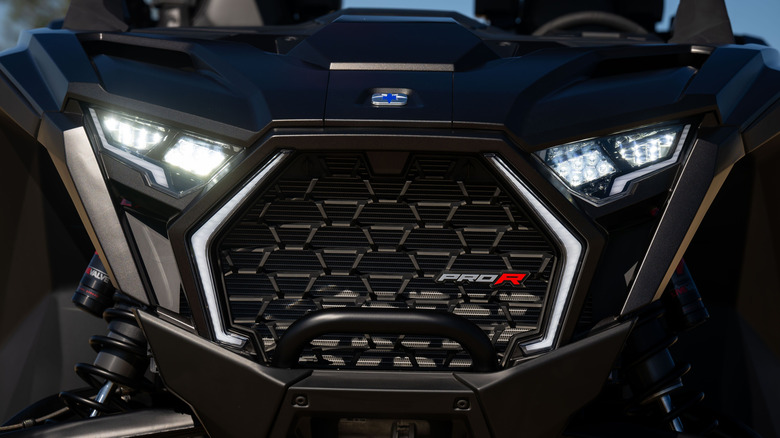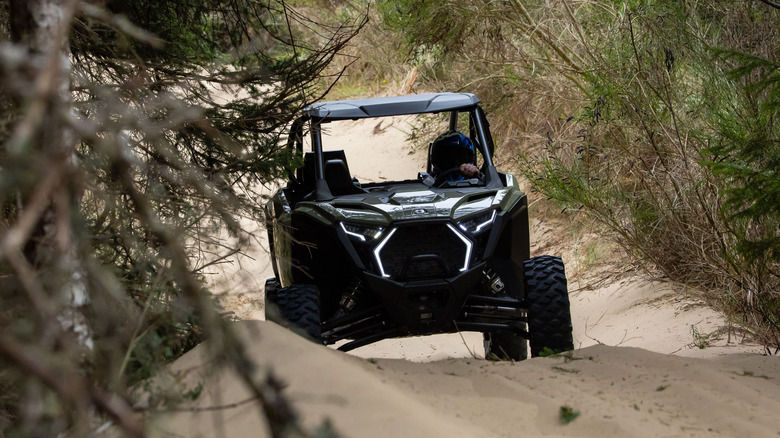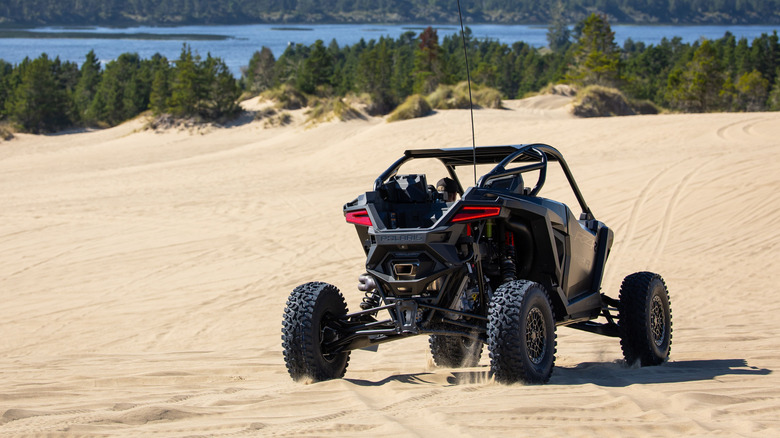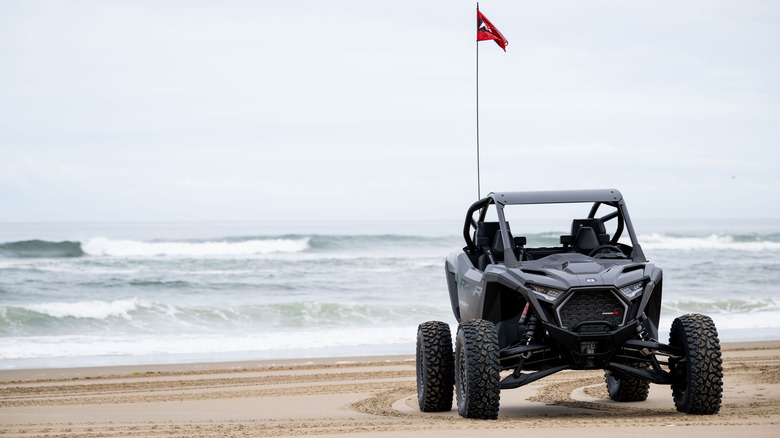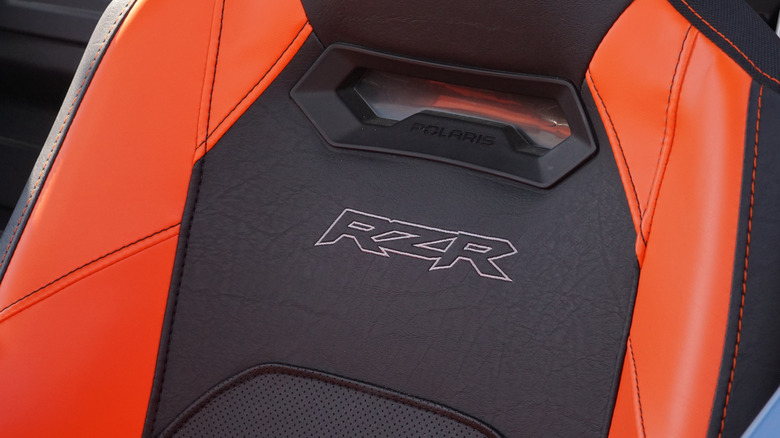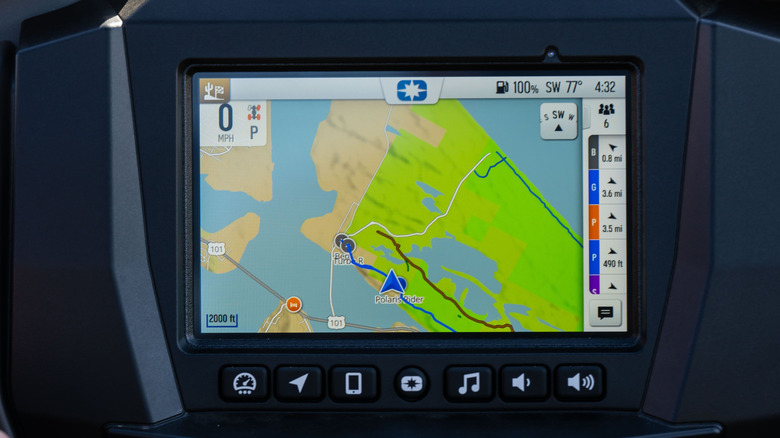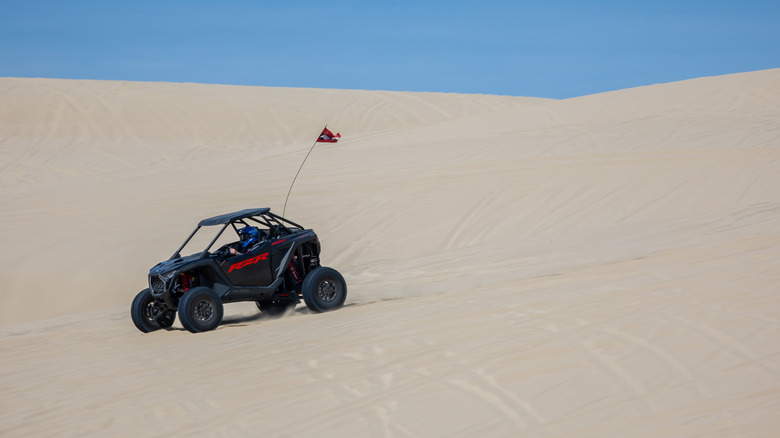2025 Polaris RZR Pro First Drive: Three Flavors Of Faster, Fiercer Side-By-Side
White-knuckling it on an unfamiliar trail, I'm trying desperately to keep up in a line of Polaris RZR Pro XP side-by-sides, with one of RZR's employees leading the way. I've done quite a bit of off-roading, spent plenty of time riding motorcycles, and all sorts of vehicle-testing driving fast sports cars, but I don't have nearly as much experience in a side-by-side. My left foot bounces wildly off the floor of the RZR, while my right foot struggles to keep in contact with the throttle, and I begin to think about the morning's safety briefing.
Then, the driving instructors told us to follow the lead driver's line and stay in the gas uphill. If you lift, you could get stuck, and with multiple RZR's right behind me, following my line, it's entirely possible that'd cause a pile up should I hesitate. The instructor also cautioned us not to stick an arm out of the side-by-side: apparently, people instinctively brace themselves by sticking an arm out straight when they roll over in the dunes, and for obvious reasons they don't want us to do that.
All of that is going through my mind as I see the RZR in front of me catch air off the top of the dune that I'm heading straight for. There's no backing out now.
All the same fun and fury
Terrified, I bury the throttle. I can feel the suspension completely decompress, then, for a second, I feel all four tires lose contact with the sand and spin freely. The screaming turbocharged two-cylinder engine revs up a few hundred RPM to confirm my suspicion: I'm airborne, traveling through the air along the Oregon coast, hoping the suspension holds up when I touch down.
There's no big thud when I hit the sand again, no violent bounce. Just a mild jolting, like an unbothered shrug. It's as if the RZR Pro turned to me and said, "that's nothing, what else ya got?"
The RZR Pro lineup of side-by-sides provide a level of off-road fun that nothing with airbags and a windshield can possibly come close to. In all likelihood, when I did catch air, it was just five or six inches from the ground and I was in zero danger of testing the RZR's limits. The base RZR XP has 22 inches of suspension travel and the RZR Pro R has 29 inches of suspension travel – more than enough to take some serious abuse. And that's part of the RZR Pro's recipe that hasn't been tossed out for 2025. The RZR Pro lineup has been updated, but the excitement of piloting one of these side-by-sides hasn't gone anywhere.
What's new for 2025
Up front, the new RZR Pro gets "fang lighting" which is Polaris' name for the LED headlights and accent lights. The headlight design is a callback to a previous fascia that got a better response from customers; so, Polaris brought back a similar aesthetic, and added a lighting animation on start-up. There are also several new features worth mentioning, including an upgraded dashboard, new solid doors, and an available Rockford Fosgate stereo with a 10-inch subwoofer.
Adding function to form, the RZR Pro also gets a new set of cabin vents that direct air towards the driver's and passenger's legs. Nostrils on the hood of the RZR lead to an adjustable air vent, so fresh air can be piped in to cool your legs on a hot day. It wasn't warm enough during our test ride to confirm the claim that these make a big difference, but on hot days it's likely to help provide a welcome rush of non-stagnant air. The top-trim RZR Pro R also gets heated and ventilated seats, a first for side-by-sides (more on that later).
RZR Pro XP
Like last year's model, there are still three flavors of Polaris' high-performance side-by-side, but the names have been updated for simplicity's sake. The new 2025 RZR Pro comes in three configurations: Pro XP, Pro S (previously known as the Turbo R), and Pro R. All three are purpose-built side-by-sides that excel at blasting through open spaces, but they do so in different ways.
The RZR Pro XP is the base model in the Pro lineup, but there's nothing basic about it. The smallest of the three versions, the XP measures 64 inches wide, giving it better agility on tight trails. The base trim level, the Pro XP Sport starts at $23,999. Top Ultimate trims start at $33,999 but there are plenty of available accessories if you're looking to spice things up even further.
Every XP is powered by a wildly-capable turbocharged two-cylinder engine that produces 181 horsepower going to either the rear or all four wheels. All models of the Polaris RZR Pro lineup are appropriately loud – you'll need earplugs, even under your helmet, if you don't want a mild headache after a day of riding – but the two-cylinder engine that powers the XP produces a soundtrack of braps and pops that feel right at home on sandy dunes.
RZR Pro S
The Pro S uses the same turbocharged two-cylinder as the XP, with peak power arriving in the 20-50 mph range. That benefits mid-corner performance, especially with the XP, but the Pro S has a wider stance, standing at 74 inches wide, which means better corner stability. Polaris says that the Pro S is more "flickable" and, in practice, that's certainly true. With the XP and especially the Pro S, a lot of steering can be done with the throttle – punching the gas induces a bit of a slide, especially on loose terrain.
The RZR Pro S starts at $26,999 with top Ultimate models kicking off at $36,999. The mid-level Premium (and the Ultimate) get RZR's Ride Command system, controlled via a 7-inch touchscreen. It provides GPS navigation and rider-grouping options that can help you keep track of other RZR riders' locations. The system is especially helpful in situations where there are multiple trails and getting lost is easy: just look for the other riders' dots on your screen, and head in that direction.
RZR Pro R
The Pro R is significantly more powerful than the XP and the S. Powered by a naturally-aspirated four-cylinder engine, the Pro R provides 225 horsepower: that's quite a bit, for something that only weighs about 2,300 pounds. From the moment you engage the throttle, the rear of the Pro R digs in, squatting and blasting forward all in the same eye-opening moment. It's also more stable at speed though, easily capable of going full-throttle across wide-open stretches of sand thanks to its 104.5-inch wheelbase.
The Pro R offers three different throttle response modes to control the fury: Sport, Rock, and Race. Race is honestly so twitchy that I turned it off after five minutes. When you're bouncing around on the dunes and in the sand, your foot tends to make uneven contact with the pedal. Then, the RZR lurches forward with each slight touch of your big toe. Rock numbs things to their lowest level for slow speed stuff, but Sport mode is the best of all three. The modes are selectable via a toggle switch on the dash, as is the change between rear- and all-wheel drive.
The Pro R is the most expensive of the bunch, with a starting price of $34,999 for the Sport model and $42,999 for the Ultimate – but for some it'll be worth the cost. The Pro R's excellent powertrain and at-speed stability put it a class above the XP and the S.
Surprising creature comforts
Perhaps the most surprising update for 2025 is that the RZR Pro has optional heated and ventilated seats. The seat bottoms have a heating element and the seat backs have the cooling element, but both features are game changers when you're out on the trail. Ripping around corners, navigating dunes, and tossing up massive rooster tails of sand is sweaty work – so getting a fan that provides your back with fresh air is a true creature comfort.
The ventilated seat back is especially useful when you're stationary, keeping your back cool when stagnant air surrounds the cabin on a hot day. With a long day on the trails, it reduced fatigue and it somehow made these incredibly-capable off-road machines feel luxurious.
The RZR Pro's seat design has been sourced from the Polaris Xpedition and, according to the RZR staff, they're the most comfortable seats they've put in any Pro product to date. Even if I did feel somewhat pained by six hours of piloting various RZR's through the dunes, I didn't feel any particular discomfort from the seats themselves. They're well bolstered, relatively form-fitting, and well padded.
Tech features
Polaris' Ride Command infotainment system is available across the RZR Pro lineup (depending on trim level) and it's easy to use, with just a few simple menus. Plugging my phone into the USB port, connecting via Bluetooth, and blasting some tunes were all easy tasks. A few times on my ride in both the Pro XP and Pro S, the system lost connection with my phone's audio but it regained that connection relatively quickly.
The RZR Pro's big, rubbery steering wheel buttons seemed clunky at first glance but they were perfect for the trails and dunes. I was going bare-handed but on a cold day with gloves on, they'd work even better. Big, easy to see and understand icons, as well as large buttons meant I didn't punch the wrong command very often.
Base trim levels of the RZR Pro come with a 4-inch LCD screen and no stereo, but upgrading to the available Rockford Fosgate system is certainly worth it. The stereo on the Ultimate trim level is a Rockford Fosgate Stage 4 unit with a 10-inch subwoofer and it's available on XP, S and R models. The system is loud enough to overpower the insane symphony of engine noises coming from behind your head. What's more, the audio system is IPX7 and IPX9K water immersion tested so it'll hold up in wet outdoor environments. A 12-inch subwoofer is also available.
Picking the right RZR Pro
The Pro XP and Pro S are seriously powerful and capable. They feel agile and playful in tight spaces, and — in side-by-side terms — they're on the more-affordable end of the spectrum. The Pro R in the Ultimate trim level is most desirable of the Polaris RZR Pros, but it's also the most expensive. The Pro R's long wheelbase makes it feel considerably more stable at speed, and the extra power provided by the 2.0-liter four-cylinder engine is intoxicating.
The wide range of trim levels, as well as the long list of available accessories means that the RZR Pro is highly customizable. There are all sorts of color combinations, the choice of two- or four-door setups, and add-ons like winches, mirrors, windshields, and even coolers designed to slide into the RZR Pro's trunk with a glove-like fit. Even the base model XP is available with plenty of custom features. No matter which configuration you go with, though, it's hard to imagine a Polaris RZR Pro failing to put a smile on your face. Just make sure you keep your arms inside, and don't let off the gas.
